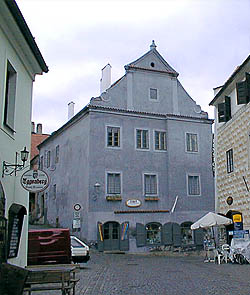Kostelní No. 169
 Location:
Location:
Kostelní No. 169
Description of the Building:
The main street front is completed with an oblong gable with side
volutes and a tympanum. The side front is newly renovated, not
articulated. The entrance staircase goes through a granite portal
with ribbon decoration with the date 1691 and with an engraved
outline of a coat-of-arms. The layout contains some barrel-vaulted
rooms, but most are rooms with flat ceilings. The cellar with stone
vaults is partly dug into the rock under the street.
Architectural and Historical Development:
The originally Gothic house was added to Kájovská
Gate - Inside in the Middle Ages. A Rennaissance reconstruction
was probably carried out in 1560 and an early-Baroque
reconstruction took place in about 1691. The second floor was added
before 1728, and the house was Classically reconstructed at the end
of the 18th century. In 1842 the gate was knocked down and the
present gable was probably built up. The house was renovated in the
1960\'s.
Significant Architectural Features:
Gothic portal with the date and coat-of-arms.
 History of the House
Residents:
History of the House
Residents:
In 1518 a certain "old Turnovská" sold this "house on stone" to a
shoemaker Mikuláš for 80 three scores of Meissen groschen. After
Mikuláš the house was gained by marriage by a butcher Petr and
after his death in 1560 it was sold by the town council to a
furrier Lorenc for 210 three scores of Meissen groschen. He
exchanged the house with a carpenter Stanzl in 1574, who sold it to
Jan Högler in 1578. Guardians of his orphans sold the house in 1622
for quite an unusually high price of 390 three scores of Meisen
groschen to Jiří Ufhauser. He died without heirs in 1626 and the
town council sold the house to Markéta, a widow after a draper
Matěj Stolz. She handed it over as a dowry to her second husband, a
hatter Štěpán Reichardt in 1629. He sold the house to a
gingerbread-maker Jan Schubert in 1641. His widow Veronika married
Lorenc Aneiss in 1647 who gained the house by marriage. His son, a
painter Petr Aneiss, later a councillor, took the house over in
1684 . The price of it was 350 three scores of Meissen groschen and
he sold it for a higher price in 1728 to a collector of the liquor
tax Filip Sassman for 600 guldens. In 1747 a tailor Šebestián Riedl
paid for the house 700 guldens. It was kept by his family until the
second half of the 19th century. In 1794 it was taken over by Josef
Riedl from mother Lucie and in 1839 by grandson Vojtěch Riedl. The
modern construction register shows no more remarkable
information.
Present Use:
On the ground floor is a factory outlet of the Koh - i - noor
Hardtmuth pencil manufacturers and on the upper floor are
flats.

